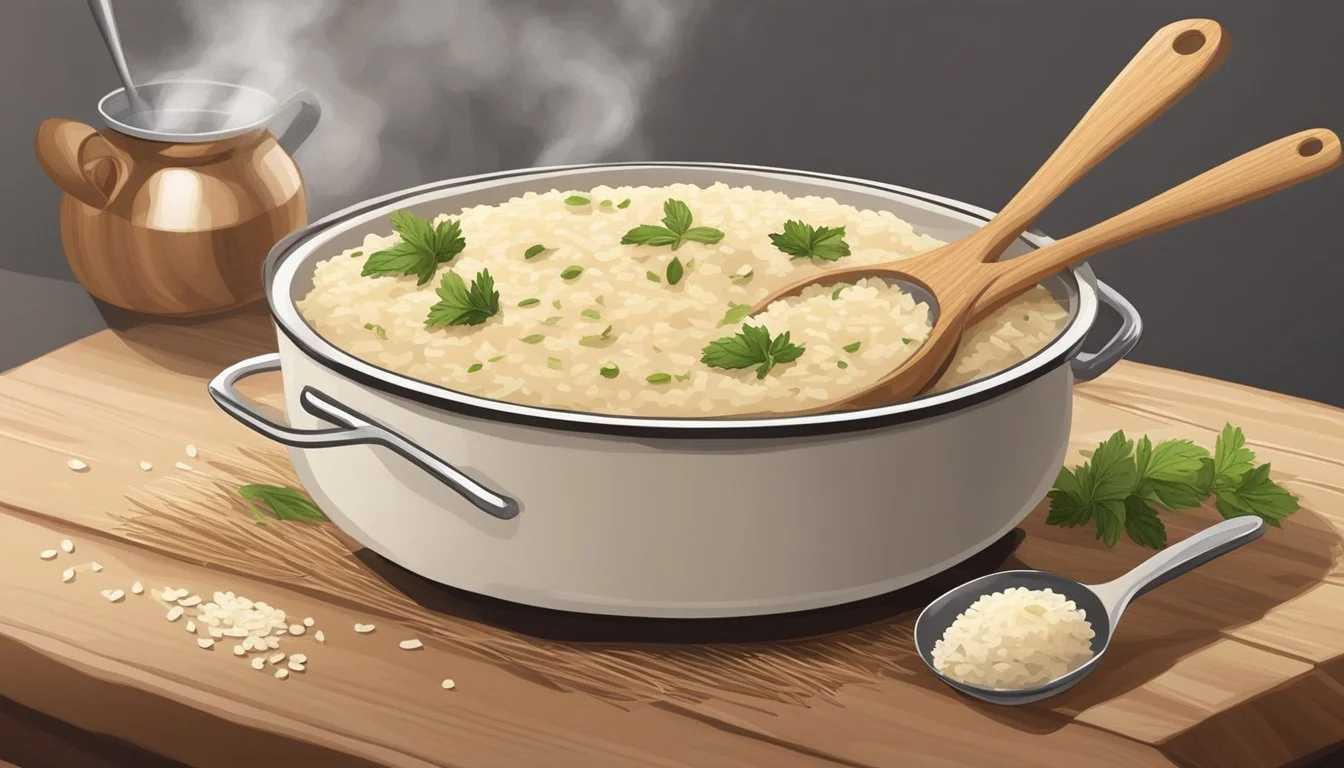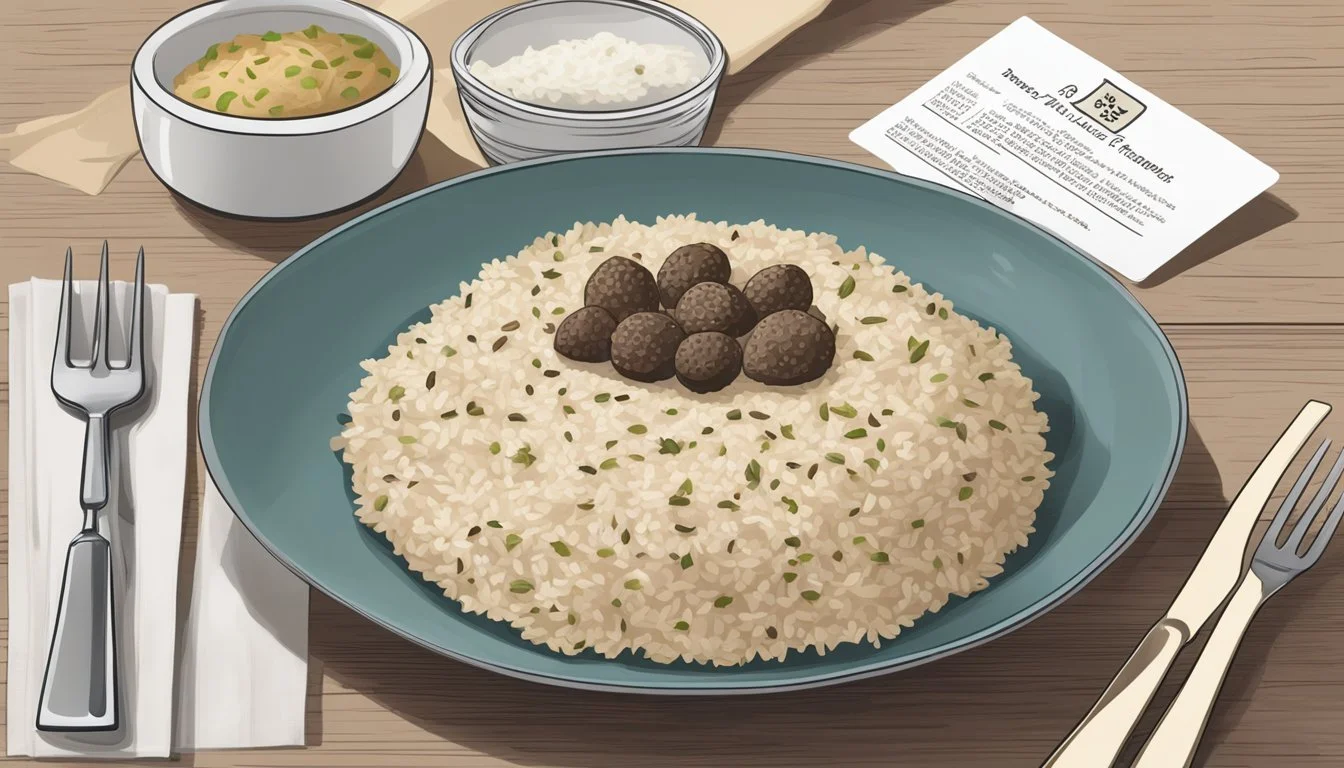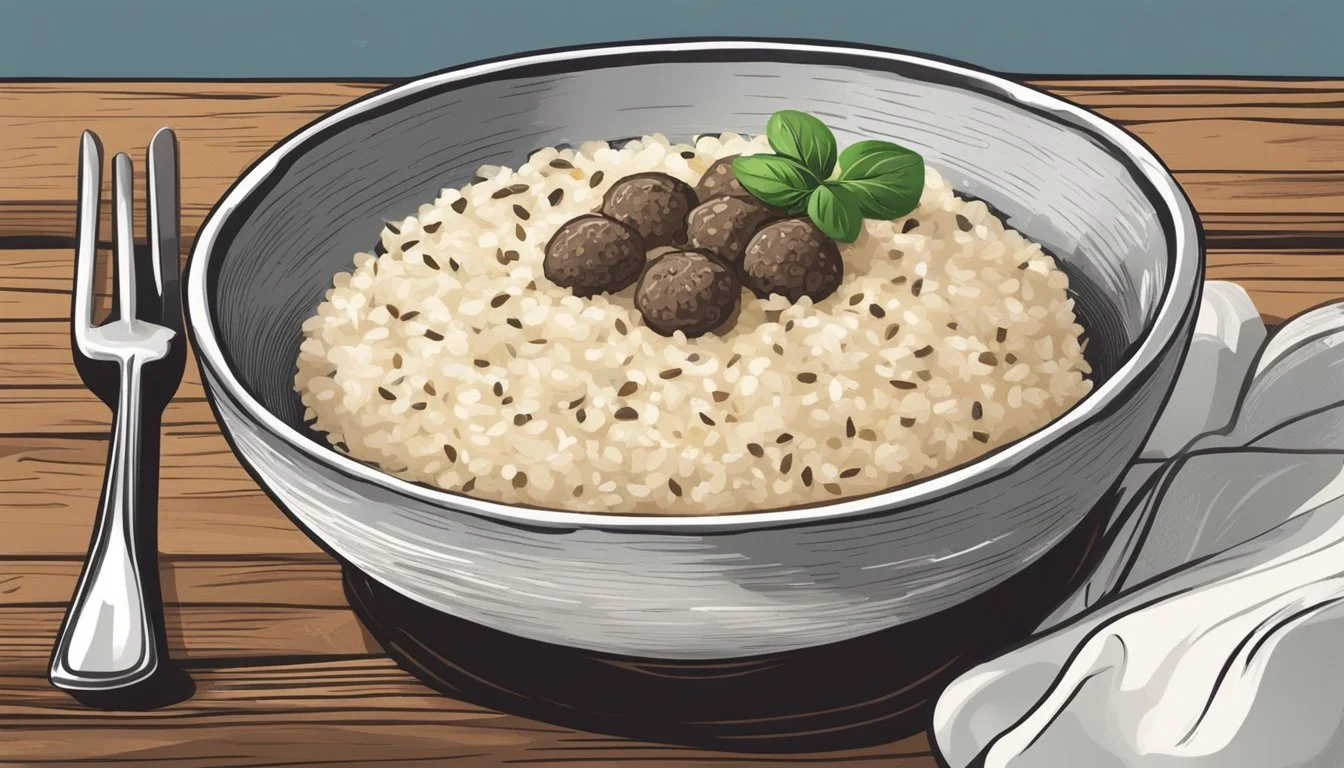How do you eat a truffle risotto?
Savoring the Delicacy with Proper Etiquette
Truffle risotto, heralded for its lush flavor profile and creamy texture, is a culinary work of art rooted in Italian tradition. The dish starts with arborio rice, known for its high starch content, which is critical to achieving the dish's signature creaminess. Essentially a canvas, the rice absorbs the rich flavors of the added ingredients. As it cooks, the starches release slowly, transforming the mixture into a velvety concoction that sets the stage for the pronounced taste of truffles (What wine goes well with truffles?).
Truffle oil, often drizzled over the finished dish, enhances the robust earthiness inherent to truffles (What wine goes well with truffles?). This decadence is balanced by the slight saltiness of freshly grated Parmesan cheese, which melds into the risotto to enrich its body and add a further layer of complexity. The inclusion of butter and oil not only contributes to the rich taste but also assists in achieving the appropriate texture; it creates a glossy sheen that beckons the palate. The marriage of these elements results in an opulent dish that, while simple in its components, demands attention to detail to perfect.
Defining Truffle Risotto
Truffle risotto, an Italian delicacy, merges the creamy texture of risotto with the earthy essence of truffles. It’s a dish that promises an indulgent savor with every spoonful, offering a balance between rich flavors and elegant simplicity.
Key Ingredients
Rice: Arborio rice is quintessential due to its high starch content, which contributes to the risotto's signature creaminess.
Liquid: Typically, stock is added incrementally to the rice, enabling the grains to release starch and become creamy.
Truffles: Both black and white truffles can be shaved over or infused into the dish, imparting a luxurious depth of flavor.
Butter/Oil: Regular butter enhances the creamy texture, while truffle butter or oil, whether white truffle oil or black truffle oil, enriches the dish with a concentrated truffle aroma.
The Role of Truffles
Truffles play a pivotal role by providing the distinctive, intense taste that sets truffle risotto apart from other varieties. The choice between black truffles and white truffles dictates the intensity and nuance of the flavor:
Black Truffle: Typically offers a more robust, earthy flavor, excellent for a heartier risotto.
White Truffle: Delivers a delicate, aromatic quality, often preferred for a subtle yet profound truffle presence.
Preparation Essentials
Mastering the preparation of truffle risotto is about attention to detail – the right rice, homemade stocks, and proper sautéing techniques enhance both flavor and texture.
Rice Cooking Techniques
Arborio rice is the cornerstone of any risotto, prized for its creamy texture and ability to absorb flavors. A gradual addition of warm broth to the rice, while stirring constantly, allows arborio rice to release its starch and become creamy without external fat sources. A vigilant eye and patience are key; the rice should be cooked to an al dente texture, which typically takes about 18-20 minutes.
Stocks and Broths
A rich, flavorful broth is crucial to a successful risotto. Choices often include chicken, vegetable, or beef broth, with chicken broth being a popular option for its subtle yet savory profile. Homemade broth can elevate the risotto significantly but if time constraints require, a high-quality store-bought broth can suffice. Always ensure the broth is heated before adding it to the rice to maintain cooking temperature consistency.
Sautéing and Layering Flavors
The foundational flavors of truffle risotto begin with sautéing shallots or onion, and garlic in a high-quality olive oil or unsalted butter until they are soft and translucent. This process should be done over medium heat to avoid burning, which could impart a bitter taste to the dish. Consequently, this base will act as the flavor bedrock for the layers of taste to follow, set by adding risotto rice to the sautéed base to toast it slightly before introducing the broth.
Cooking the Perfect Risotto
Crafting the perfect truffle risotto involves three crucial elements: attaining the ideal al dente texture, ensuring a creamy consistency throughout, and flawlessly incorporating the distinctive taste of truffle. Adherence to these principles will yield an exquisite dish.
Achieving the Al Dente Texture
One of the hallmarks of a well-made risotto is rice that's cooked al dente - firm to the bite but not hard. This can be achieved by using high-starch, short-grain rice varieties like Arborio or Carnaroli, which are traditional in risotto making. The process typically involves adding warm stock to the rice gradually, allowing the grains to absorb the liquid slowly. The rice should be stirred consistently but gently, as vigorous stirring can cause grains to break. This process usually takes around 18-20 minutes, with the rice being tender yet still having a slight bite.
Maintaining Creaminess
The creaminess of risotto doesn't come from cream itself but from the starches in the rice. As the rice cooks and stirs, the outer layer of starch is released, creating a creamy consistency. To ensure this creamy texture is achieved:
Stock: Add warm stock in half-cup increments; cold stock can shock the rice and halt the release of starch.
Stirring: Stir the rice frequently but not constantly to prevent it from turning mushy.
Butter: Integrate a knob of butter at the end of cooking to enhance the rich, velvety quality of the dish.
A perfect risotto should flow like lava when plated, indicating the ideal creamy consistency.
Incorporating the Truffle
Truffle should be incorporated with a careful balance to not overpower the other flavors. The truffle's strong aroma and taste can enhance a risotto when used judiciously. High-quality truffle butter can be added just before finishing to infuse the dish with truffle essence while preserving its texture. Additionally, freshly grated parmesan cheese can complement the truffle's earthiness without dominating the dish. A fine grating of fresh truffle over the top just before serving adds an extra layer of luxury and aroma that is the signature of any truffle risotto.
Complementing Flavors and Additions
Enhancing the savory indulgence of truffle risotto, one can artfully select proteins, vegetables, and wines that not only match but elevate the dish's rich character.
Pairing with Proteins
Chicken: A well-prepared chicken breast, with its mild flavor and tender texture, is an excellent match. It can be simply grilled or roasted to maintain the risotto's prominence.
Seafood: For a luxurious pairing, one might opt for seared shrimp, buttery lobster, or pan-seared scallops (What wine goes well with scallops?), which complement the truffle's earthy tones.
Choosing the Right Vegetables
Mushrooms: Additional mushrooms, such as porcini or chanterelles, offer a deeper earthy essence that echoes the truffle's intrinsic flavors.
Greens: Asparagus or leeks can introduce a fresh, slightly sweet contrast, which cuts through the richness without overpowering the palate.
Wine Pairing Suggestions
Dry White Wine: A crisp, dry white wine, such as a well-balanced Chardonnay, cuts through the creaminess while complementing the umami elements.
White Wine: For those who prefer a less dry option, a lighter-bodied white wine can still provide a refreshing counterpoint to the risotto's decadent profile.
Serving and Presentation
When presenting truffle risotto, the approach to plating and garnishing plays a significant role in enhancing the dining experience. It allows the rich flavors to be complemented by visual appeal, ensuring a memorable meal.
Plating Techniques
To plate truffle risotto, one should ensure that the dish is served hot to maintain its creamy texture. A warm, shallow bowl is ideal as it showcases the risotto's consistency and allows for even distribution of heat. Spoon the risotto into the center of the bowl, creating a mound that is not too flat nor piled too high. This will focus the diner’s attention on the dish’s centerpiece.
Garnishing for Aesthetics
Garnishing is crucial for adding both visual appeal and subtle flavor complements to the dish. Finish the truffle risotto with a conservative amount of freshly grated Parmesan, which melts into the risotto for a slightly nutty flavor and creamy texture. Lightly sprinkle chopped parsley over the top for a pop of color. This not only adds a fresh taste but also contrasts beautifully with the creamy risotto. Choosing the right side dish can enhance the risotto's flavor, so consider serving it with something that offers a textural contrast, such as a simple green salad or roasted vegetables.
Nutritional Information
Truffle risotto, a luxurious and creamy dish, is known for its rich flavor profile, but it is also important to consider its nutritional aspects. This section provides precise information on its caloric content and dietary considerations to help make informed choices when enjoying this indulgent meal.
Caloric Content
Truffle risotto typically presents a significant caloric figure due to its rich ingredients. On average, a serving size may contain:
Calories: 310-440
Total Fat: 18g, with Saturated Fat at 6.7g
Carbohydrate: 66.7g
Sugars: Typically low
Protein: Approximately 12.3g
These values can vary depending on specific recipe variations and serving sizes.
Dietary Considerations
Individuals with dietary restrictions or health concerns should be mindful of the following components in truffle risotto:
Fat: It includes both saturated and unsaturated fat, which contribute to the overall calorie count.
Sodium: Some recipes may have high sodium content, with certain brands reaching up to 1193mg per 100g serving.
Cholesterol: Varies based on ingredients such as cheese and butter.
Vegetarian: Often suitable for vegetarians, but one should verify the type of stock used.
Gluten-Free: While rice is naturally gluten-free, cross-contamination or certain additives may introduce gluten.
Careful consideration of these nutrients ensures a balanced approach to enjoying truffle risotto.
Storage and Reheating
When it comes to truffle risotto, maintaining its creamy texture and rich flavor after initial preparation is crucial. Proper storage and reheating methods ensure that the risotto retains its desired qualities.
Keeping Leftovers
Leftovers should be stored promptly to maintain the quality of the truffle risotto. Storage instructions are simple:
Cooling: Allow the risotto to cool to room temperature within 2 hours of cooking to prevent bacterial growth.
Storing: Transfer the cooled risotto to an airtight container.
Refrigeration: Place the container in the refrigerator, where it can be safely stored for up to 5 days.
Best Practices for Reheating
Reheating truffle risotto requires gentle heat to restore its creaminess without drying it out. The following methods are recommended:
On the Stove: Use a large pan, adding 3 tablespoons of broth or water per cup of risotto to prevent dryness while reheating over low heat, stirring frequently.
Microwave: If using a microwave, add a splash of broth or water, cover loosely, and heat in short intervals, stirring every 30 seconds to ensure even warming.
It's important to add liquid, like low-sodium chicken or vegetable broth, as the rice will have absorbed the initial cooking liquid and may become too dry otherwise. Heating should be done just until the risotto is warmed through, and additional cheese can be stirred in after reheating to refresh the flavor.
Frequently Asked Questions
What is the key to successful truffle risotto?
The secret is to use good-quality stock and add it in increments, allowing the rice to absorb the liquid slowly. This method releases the rice's natural starches, which gives risotto its classic creamy texture.
How can one best preserve the flavor of truffles in a risotto?
To maximize the truffle aroma and flavor, it should be added towards the end of cooking. Grate or shave it on top just before serving, as heat can dissipate its rich flavor.
Is truffle risotto suitable for a dinner party?
Absolutely. Truffle risotto is an elegant and indulgent dish that is sure to impress guests. It's a gourmet choice that pairs well with a variety of wines and sides.
Can vegetarians enjoy truffle risotto?
Yes, with vegetable stock instead of traditional chicken or beef stock, vegetarians can enjoy a sumptuous version of this dish.
What type of rice is best for making risotto? Arborio rice is preferred due to its high starch content, which contributes to the creaminess of the risotto. Carnaroli and Vialone Nano are also excellent choices.
Ingredient Suggested Quantity Arborio Rice 1 cup Stock 4 cups, heated Onions/Shallots 1/4 cup, finely chopped Fresh Truffles To taste, shaved or grated Parmesan Cheese As desired, freshly grated Olive Oil/Butter 1-2 Tbsp for sautéing
Remember to stir frequently and serve the risotto al dente for the most authentic texture.
Conclusion
Truffle risotto embodies a special culinary experience, enriched by the delicate flavors that truffles bring to this classic Italian dish. When one indulges in truffle risotto, it is essential to appreciate the balance of flavors and the creamy texture that is a hallmark of this delicacy. Taking a moment to savor the aroma before tasting can enhance the overall enjoyment.
A few tips to keep in mind:
Serve Promptly: Truffle risotto should be served immediately after cooking, as it is when the risotto's texture is at its most luscious.
Portion Sizes: As truffle risotto is quite rich, smaller portions are advisable to prevent overpowering the palate.
Pair with Simplicity: A simple green salad or steamed vegetables can complement the risotto, ensuring the truffle remains the star of the meal.
Wine Pairing: A glass of full-bodied white wine, such as a Chardonnay or a light-bodied red, like Pinot Noir, can balance the earthy truffle flavors.
In Italy, where the dish traces its roots, chefs use high-quality ingredients and it is advised for anyone replicating the recipe to do the same for an authentic taste. Fresh truffles, when in season, and a good quality risotto rice are crucial components.
The allure of truffle risotto lies not in just its taste, but also in its simplicity and the careful attention to detail required in its preparation. Deviating from the fundamental techniques can result in a dish that doesn’t do justice to the traditional Italian risotto or the prized truffles it features. Enjoying truffle risotto is about embracing the subtleties and recognizing the intertwining of simple yet high-quality ingredients to create a dish that is far greater than the sum of its parts.









